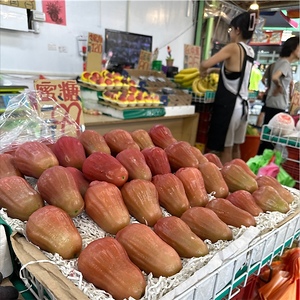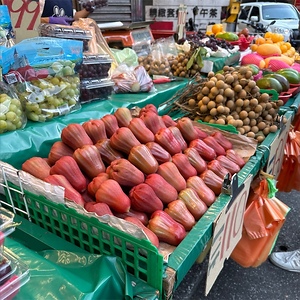


Brown Sugar Barbie Wax Apples
Estimated Inventory, lb : 0
Description/Taste
Brown Sugar Barbie wax apples are a large varietal, averaging 5 to 8 centimeters in diameter and 9 to 10 centimeters in length, and have a bell-like shape with a narrow, curved neck widening to a broad, slightly flattened base. Each fruit averages 200 to 300 grams in weight, sometimes growing as large as 380 grams, and typically showcases a closed base, also called a navel, which is an important visual characteristic. Brown Sugar Barbie wax apples have thin, smooth, glossy, and taut skin, exhibiting prominent ridges and striations across the surface. The skin also ripens to shades of pale red, dark red, and purple-red, with the darkest pigmented fruits appearing during the winter. Underneath the surface, the pale green-white flesh is crisp, aqueous, airy, and crunchy. The flesh beneath the skin has the highest water content, while the flesh in the fruit’s center becomes spongy and cotton-like. Brown Sugar Barbie wax apples are seedless or contain a tiny, underdeveloped black-brown seed. Select fruits that feel heavy for their size and have a plump, firm feel. Brown Sugar Barbie wax apples have a high sugar content, ranging from 12 to 14 Brix, creating a mild, sweet, sour, and refreshing taste. The base of the fruit is typically the sweetest portion of the flesh, becoming milder towards the stem end.
Seasons/Availability
Brown Sugar Barbie wax apples are available year-round, with a peak season from January through July. Each region in Taiwan will have varying availability, depending on the growing environment.
Current Facts
Brown Sugar Barbie wax apples, botanically classified as Syzygium samarangense, are a Taiwanese variety belonging to the Myrtaceae family. Wax apples are a traditional crop throughout Taiwan that has been treasured as a fresh-eating fruit for their refreshing texture and flavor. Historically, wax apple varieties were smaller and varied in coloring and taste, but in the early 21st century, government breeding programs began producing new varieties to increase diversity in the fresh market. Brown Sugar Barbie wax apples are a hybrid cultivar developed through a national breeding program in Taiwan in the early 21st century and was selected as a commercial variety for its improved characteristics. Brown Sugar Barbie wax apples are one of the largest varieties currently grown in Taiwan, and the bell-shaped fruits are crisp, firm, and juicy, with ample amounts of edible flesh. Consumers favor the variety for its size, dark red coloring, and sweet and sour taste. Brown Sugar Barbie wax apples are also valued by growers for their hardiness, productivity, and durability. The variety is more resistant to cracking than other cultivars and can withstand transportation, allowing it to be used as a possible export fruit. Brown Sugar Barbie wax apples are a labor-intensive crop. Each cluster of fruit is bagged by hand to protect the fruit’s surface from fruit flies, other insects, weather damage, and birds, and each branch is thinned to produce only 5 to 7 fruits to increase their overall size. The fruits can easily fall from the branches during cultivation and are carefully handled when harvested to protect their pristine appearance. Once picked, Brown Sugar Barbie wax apples are promoted in fresh markets as a premium variety. The cultivar produces multiple crops throughout the winter, spring, and summer seasons, and they are often sold in gift boxes as presents for special occasions. Brown Sugar Barbie wax apples are also known as Tainung No. 3 or Tainong No. 3 wax apples, their true varietal name, and are a variety increasing in notoriety as they are expanding in production across Taiwan.
Nutritional Value
Brown Sugar Barbie wax apples have not been extensively studied for their nutritional properties. Wax apples, in general, are a source of fiber to regulate the digestive tract, potassium to balance fluid levels within the body, vitamin C to strengthen the immune system, vitamin A to maintain healthy organs, and calcium to build bones and teeth. Wax apples also provide anthocyanins, natural compounds within the fruits that contribute to their red, pigmented hue. Anthocyanins have antioxidant-like properties to protect the body against the damage caused by free radicals and reduce inflammation. In traditional Chinese Medicine, wax apples are believed to help moisten the lungs, soothe sore throats and coughs, and reduce phlegm. They are also consumed to cool the body on hot days and provide a source of hydration.
Applications
Brown Sugar Barbie wax apples have a mildly sweet and sour taste suited for fresh and cooked preparations. The fruits are traditionally eaten out of hand and are enjoyed for their light, crisp, juicy, and airy taste. Brown Sugar Barbie wax apples are famed for their large size, providing ample amounts of flesh, and both the skin and flesh are eaten after washing. The flesh has an aqueous texture just below the skin, becoming spongier and cotton-like towards the center. Brown Sugar Barbie wax apples can be bitten like an apple or sliced into pieces. When sliced, the juicy pieces can be consumed with spicy, aromatic dips for added flavoring. Some consumers also dip the fruits in plum powder or soak pieces in salt water for enhanced taste. Brown Sugar Barbie wax apples can be diced into salads or blended into various beverages and smoothies with honey, ice, and other fruits. In addition to fresh preparations, wax apples are popularly stir-fried with meats, ginger, and garlic, served over rice, or stewed with sugar and made into syrups and jams. They are also hollowed, stuffed with meat, and steamed. Brown Sugar Barbie wax apples pair well with corn, cucumbers, bell peppers, fruits such as pears, kiwis, lime juice, bananas, and coconuts, aromatics including cilantro, garlic, and ginger, and flavorings such as vinegar, sesame oil, and mirin. Wax apples should be immediately consumed after harvest for the best quality and flavor and will keep for a few days at room temperature. They can also be stored in a sealed container in the refrigerator’s crisper drawer for up to one week.
Ethnic/Cultural Info
Brown Sugar Barbie wax apples acquired their commercial name from their sweet taste and premium characteristics. When the variety was initially introduced under the name Tainong No. 3 to Taipei’s No. 1 Fruit and Vegetable Market, it is said that the fruits sold for as high as NT$1,050 per kilogram. This high price was compared to being as expensive as a handmade Barbie doll, leading the variety to be named Brown Sugar Barbie. In Taiwan, wax apples have also been nicknamed belly button fruit. Before cultivation expanded to create varieties with improved characteristics, wax apples were grown freely in home gardens and landscapes. When left to grow naturally, wax apples can sometimes develop a flared base referred to as a navel. This part of the fruit became playfully known as a belly button among children who would pick the fruits as a refreshing snack. The wax apple shape also later became a term used to describe a nose shape among indigenous Taiwanese communities. In the modern day, the concept of the belly button still exists among wax apple cultivation. The preferred appearance of the fruits in commercial markets has closed navels, as this flat base allows the fruits to stand upright for increased visual appeal. Most Brown Sugar Barbie wax apples are grown to have a flat navel, and this characteristic makes them a popular choice for gifts given to coworkers, friends, and family during special occasions and holidays such as the Lunar New Year.
Geography/History
Brown Sugar Barbie wax apples are native to Taiwan and are a hybrid variety developed in the early 21st century. Wax apples, in general, were introduced into Taiwan through trade endeavors conducted by the Dutch East India Company’s colony on the island sometime during the 17th century. The species has origins in the Malay Peninsula, spreading throughout Southeast Asia in ancient times, and the first varieties planted in Taiwan were said to have been carried from Java. Wax apples were initially a home garden fruit in Taiwan, but various species were selectively bred over time for improved cultivation traits. Varieties were also introduced from other Southeast Asian regions, including Thailand and other parts of Indonesia. In the early 21st century, the Fengshan Tropical Horticultural Experiment Branch of the Agricultural Experimental Institute in Kaohsiung City, Taiwan, began breeding new types of wax apples for increased production, diversity, and improved varieties. Breeding started in 2005, and the first official release, Tainong No. 1, also known as the Amethyst variety, was introduced in 2011. Several years later, in 2014, the breeding program released Tainong No. 3, a new variety developed from Indonesian wax apples and other unknown cultivars. Tainong No. 3 was created by researcher Chi Cho Huang and was selected as a new variety for its larger size, sweeter taste, hardiness, and red coloring. The variety was initially planted in the Liugui District in Kaohsiung City and slowly expanded in production to regions throughout Southern Taiwan. Tainong No. 3 was also given the commercial brand name Brown Sugar Barbie for increased consumer appeal. Today, Brown Sugar Barbie wax apples are produced in Southern Taiwan, mainly in Pintung County and Kaohsiung, but they are also grown in smaller quantities throughout the island in Chiayi, Nantou, New Taipei, and Yilan Counties. When in season, Brown Sugar Barbie wax apples are sold individually in fresh markets or are carefully packaged in ornate gift boxes as a luxury item in high-end fruit retailers. Brown Sugar Barbie wax apples are also sold through home delivery companies, direct sales platforms through farms, or exported to other countries in Asia. The Brown Sugar Barbie wax apples featured in the photograph above were sourced from a farm in Pintung County, Taiwan.









